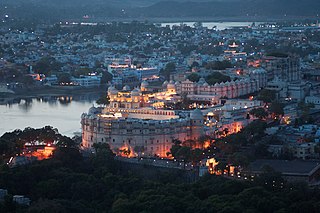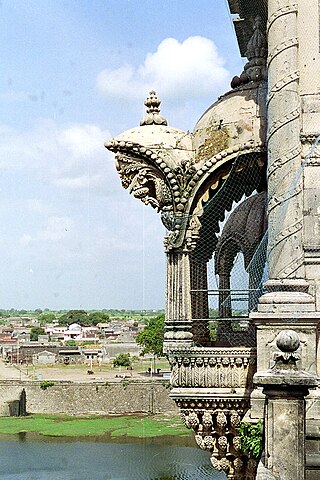
Sabarkantha district is one of the 33 districts of Gujarat state of India, located in the northeastern part of the state. The administrative headquarters of the district are located in Himatnagar.

Bhil or Bheel refer to various indigenous groups inhabiting western India, including parts of Rajasthan and Madhya Pradesh and are also found in distant places such as Bengal and Tripura. They speak various languages of Indo-Aryan origin, owing to language shift, collectively referred to as the Bhil languages. Bhils are divided into a number of endogamous territorial divisions, which in turn have a number of clans and lineages.

Pushkar Lake or Pushkar Sarovar is located in the town of Pushkar near Ajmer city in Ajmer district of the Rajasthan state of western India. Pushkar Lake is a sacred lake of the Hindus. The Hindu scriptures describe it as "Tirtha-Guru" [Thirtha Raj]– the perceptor of pilgrimage sites related to a water-body and relate it to the mythology of the creator-god Brahma, whose most prominent temple stands in Pushkar. The Pushkar Lake finds mention on coins as early as the 4th century BC.

Udaipur district is one of the 50 districts of Rajasthan state in western India. The historic city of Udaipur is the administrative headquarters of the district. The district is part of the Mewar region of Rajasthan.

Udaipur is a city in the north-western Indian state of Rajasthan, about 415 km (258 mi) south of the state capital Jaipur. It serves as the administrative headquarters of Udaipur district. It is the historic capital of the kingdom of Mewar in the former Rajputana Agency. It was founded in 1559 by Udai Singh II of the Sisodia clan of Rajputs, when he shifted his capital from the city of Chittorgarh to Udaipur after Chittorgarh was besieged by Akbar. It remained as the capital city till 1818 when it became a British princely state, and thereafter the Mewar province became a part of Rajasthan when India gained independence in 1947. It is also known as the City of Lakes, as it is surrounded by five major artificial lakes.

Junagarh Fort is a fort in the city of Bikaner, Rajasthan, India. Raja Dhaj, Ror Kumar, ruled over the principality of Junagarh in the fifth century BC. The fort was originally called Chintamani and was renamed Junagarh or "Old Fort" in the early 20th century when the ruling family moved to Lalgarh Palace outside the fort limits. It is one of the few major forts in Rajasthan which is not built on a hilltop. The modern city of Bikaner has developed around the fort.

Khedbrahma is a town and a taluka headquarter in Khedbrahma Taluka of Sabarkantha district, Gujarat, India. It is situated on the banks of Harnav river. The town is connected with mythological history and has been pilgrim site for centuries. The 11th century Brahma, Ambika and Pankhnath Mahadev temples are the oldest monuments of the town. The town has an old stepwell, the Brahma Vav. It was under Parmaras, Chaulukyas and Pariharas before it came under Idar State in 13th century.

Samode Palace, Samode Haveli and Samode Bagh (Garden) are heritage monuments and structures built by the noble feudatory with the hereditary title of 'Maha Rawal' or 'Maha Saheb’ of the Amber and Jaipur principality in Rajasthan, India. All three have rich history of several hundred years and display a fusion of Mughal and Rajasthani art and architecture. They are now part of the Heritage group of hotels under the flagship name of "Samode" that are run by the hereditary owners of these structures. The Samode Palace is located 40 kilometres (25 mi) north of Jaipur city, the Samode Haveli is close to Jaipur (centrally located within city limits, 6 kilometres (3.7 mi) away from the city railway station) and the Samode Bagh or Garden, 4 kilometres (2.5 mi) from the palace which is also run as a luxury hotel.

Brahma Temple, Pushkar is a Hindu temple situated at Pushkar in the Indian state of Rajasthan, close to the sacred Pushkar Lake to which its legend has an indelible link.

Bhogilal Pandya (1904-1981) was a freedom fighter and social worker from Dungarpur in the Indian state of Rajasthan. On 3 April 1976, the Government of India awarded him the Padma Bhushan for his social services. The Padma Bhushan is the third-highest civilian award in the Republic of India, given for distinguished service to the nation. For his championing of education and rights for the poor and underprivileged, he is referred by the people of Rajasthan as "Gandhi of Vahgad". His home is in the Gandhi aashram area of Dungarpur.
The culture of Gujarat is both ancient, new, and modern.

Jag Mandir is a palace built on an island in the Lake Pichola. It is also called the "Lake Garden Palace". The palace is located in Udaipur city in the Indian state of Rajasthan. Its construction is credited to three Maharanas of the Sisodia Rajputs of Mewar kingdom. The construction of the palace was started in 1551 by Maharana Amar Singh, continued by Maharana Karan Singh (1620–1628) and finally completed by Maharana Jagat Singh I (1628–1652). It is named as "Jagat Mandir" in honour of the last named Maharana Jagat Singh. The royal family used the palace as a summer resort and pleasure palace for holding parties. The palace served as a refuge to asylum seekers for one occasion.

The Naulakha Palace, the oldest extant palace in Gondal, India, dating back to the 18th century (1748) during the reign of Haloji Sagramji, with a "sculpted facade" is a part of the Darbargardh fort complex. It is named "Navalakaha" meaning rupees "nine lakhs" which was the cost of building it at that time. It has stone carvings with "jharokhas" (balconies), a pillared courtyard, delicately carved arches, and a unique spiral staircase. The large chandelier-lit "durbar" hall witnesses stuffed panthers, gilt wooden furniture, and antique mirrors. The "private palace museum" displays an array of silver caskets which were in the services of carrying messages and gifts for the Maharajah Bhagwat Sinhji on his silver jubilee as ruler of Gondal. The palace is situated in Gondal city, which is well connected by road, rail and air services. It is located 38 kilometres (24 mi) away from Rajkot, which is also the airport and rail head.

The Vagri are a tribe and caste found in the states of Rajasthan and Gujarat in India, and in the province of Sindh in Pakistan.

Aravalli district is a district in the state of Gujarat in India that came into being on August 15, 2013, becoming the 29th district of the state. The district has been carved out of the Sabarkantha district. The district headquarters are at Modasa.
Simalwara is a census town in Dungarpur district in the Indian state of Rajasthan. It is the administrative headquarters for Simalwara Tehsil.
Poshina (Ratanpur) is a town in Poshina Taluka in Sabarkantha district of Gujarat state, India. It is located in the northernmost side of Sabarkantha district, 70 km from Idar.

Kotra is a tehsil of Udaipur district in Rajasthan, India, consisting of 262 revenue villages and 31 panchayats. The tehsil is bordered to the north by Pali and Sirohi districts, to the east by Gogunda and Jhadol tehsils, and to the south by Gujarat state. The tehsil headquarter is located in the village of Kotra, southwest of the Udaipur at a distance of 57 km and 120 km by road.

Jhadol tehsil is an administrative sub-division of Udaipur district in Rajasthan, India. Jhadol tehsil was formerly called Phalasia tehsil. The tehsil consists of 283 revenue villages and 45 panchayats. The tehsil headquarter is located in the village of Jhadol, southwest of the district headquarters, Udaipur.

The Wakal River is a tributary to the Sabarmati River in Rajasthan and Gujarat states of India.

















